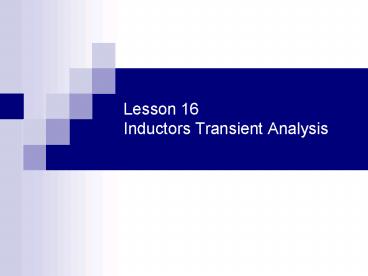Lesson 16 Inductors Transient Analysis - PowerPoint PPT Presentation
1 / 15
Title:
Lesson 16 Inductors Transient Analysis
Description:
Inductors Transient Analysis Learning Objectives Calculate inductor voltage and current as a function of time. Explain inductor DC characteristics. – PowerPoint PPT presentation
Number of Views:134
Avg rating:3.0/5.0
Title: Lesson 16 Inductors Transient Analysis
1
Lesson 16Inductors Transient Analysis
2
Learning Objectives
- Calculate inductor voltage and current as a
function of time. - Explain inductor DC characteristics.
3
Inductor Charging
- Inductor Oppose Changes (Choking effects)
- Inductor is initially fully discharged
- acts like a open circuit
- When switch is closed, the changing current
across the inductor immediately induces a voltage
that opposes that change, which keeps the current
near zero
4
Inductor charging
- As current iL builds up, the voltage across the
R1 resistor increases.
5
Inductor Charging Equations
- Voltages and currents in a charging circuit
change exponentially over time
6
Steady State Conditions
- Circuit is at steady state voltage and current
reach their final values and stop changing - There is no change in current in the circuit, so
the inductor has zero voltage induced across it.
Inductor current will be steady - Inductor then looks like a short circuit
7
The Time Constant
- Rate at which an inductor charges depends on R
and L, which is called the TIME CONSTANT - Transients can be considered to last for five
time constants
8
Example Problem 1
- In the circuit below, the switch is initially
open and conditions are at steady-state. - After the switch is shut, determine
- how long it will take for the inductor to reach a
steady-state condition (gt99 of final current). - Write the equation for the VL(t) iL(t).
Sketch the transient. - Find the Energy stored in the Inductor.
9
Interrupting Current in an Inductive Circuit
- When switch opens in an RL circuit
- Energy is released in a short time
- This may create a large voltage
- Induced voltage is called an inductive kick
- Opening of inductive circuit may cause voltage
sparks of thousands of volts
10
Interrupting a Circuit
- Switch flashovers are generally undesirable
- They can be controlled with proper engineering
design - These large voltages can be useful
- Such as in automotive ignition systems
11
Inductor Discharging
- Inductor is initially fully charged with constant
100 ma current through it. It acts like a short
circuit - When switch is opened, the inductor will
immediately induce a voltage to keep the 100 mA
current constant. - KVL can be used to calculate this induced voltage
- Notice the polarity of the induced voltage!
12
Inductor Discharging
- As stored energy is released, the induced
voltage across the inductor drops. - This makes the voltage drop across the resistor
drop, so current in the circuit drops
13
Inductor Discharging Equations
- Voltages and currents in a discharging circuit
also change exponentially over time
14
The Time Constant
- Rate at which an inductor discharges depends on R
and L, which is called the TIME CONSTANT - Transients can be considered to last for five
time constants
15
Example Problem 2
- The circuit shown below has been in operation
with the switch shut for a long time. The switch
opens at time t 0, determine - how long it will take for the inductor to
discharge. - Write the equation for the VL, iL,. Sketch the
transient.































